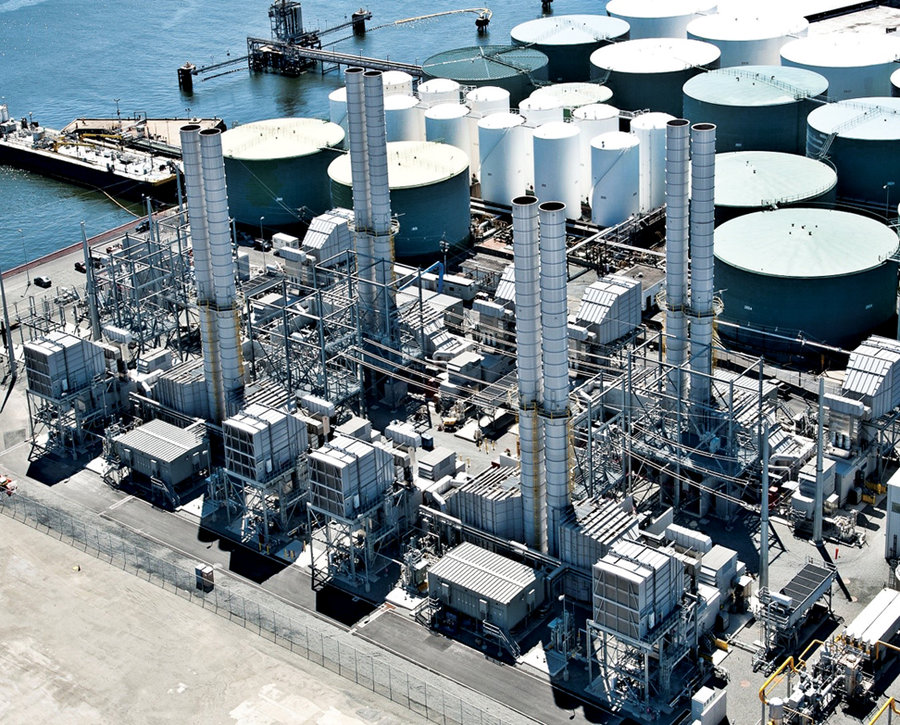Excavators are at work clearing the way for two new gas turbines on a 6.25-acre plot of land at the Bayonne Energy Center (BEC). The new turbines, Trut 60 simple cycle fast start gas turbines, are due to be fully operational by December 31, 2017, and will be added to the eight already in operation to increase the center’s energy capacity 25 percent from 512 megawatt hours to 644. The land was former International Matex Tank Terminal (IMTT) property. IMTT was bought out in full in 2014 by Macquarie Infrastructure Company (MIC), which subsequently bought BEC in 2015 for $720 million and acquired the land beneath the BEC in December 2015.
The BEC came online in 2012 for the expresspurpose of transmitting that electricity throughthe longest cross-linked polyethylene (XLPE) cable in the world, also finished in 2012, running from the BEC under New York Harbor and to the Con Edison-owned Gowanus Substation in Brooklyn to power the New York City grid.
The expansion was announced last year, but the BEC got the official go-ahead only after receiving a 30-year tax abatement last month to develop the 6.25-acre plot, making annual payments of 2 percent of its construction costs instead of paying the normal tax rate, according to City Tax Assessor Joe Nichols.
Shawn Picard, Facility Manager for Ethos Energy, the company that manages the facility, said that the turbines work the way he was taught in college. “Suck, squeeze, bang, blow,” he said.“They suck in air, they squeeze it, they compress it, they combust fuel with that air, and they exhaust it.” The compressed air is then shot back into the turbine’s compressor to keep the process going.
The duel-fuel turbines operate primarily on natural gas, but burn ultra-low sulfur diesel for backup. According to Picard, the dirty-burning diesel fuel isused only when natural gas is curtailed, “during something like a polar vortex, so when we have ridiculously cold weather and there’s no natural gas in the system.”
Small, but powerful
“One of the really unique things about this facility is the amount of power that is put into such a small footprint,” said Picard. “So when you go anywhere else in the world, you have this amount of power on twice the footprint.”The facility is small and dense, with eight turbines packed together like a miniature industrial city, which “enabled us to maximize the power put into New York City,” said Picard.“There wasn’t any more land to be had out here, so this is it. We didn’t have anywhere else to go.”
Not only is the site small relative to its energy output, it employs only 13 people, six from Bayonne, including Picard, who said,“There’s a lot of automation that goes into it. There’s only two people on shift at a time.” Those employees are operating equipment, making inspection watch rounds, and making sure the equipment is operating in compliance with New Jersey Department of Environmental Protection air permits, ensuring that the facility does not emit more carbon monoxide and nitric oxide than is legally allowed.
“One of the really unique things about this facility is the amount of power that is put into such a small footprint.” – Shawn Picard
____________
Gas consumption
In a Short-Term Energy Outlook report issued by the U.S. Energy Information Administration in September, the country’s natural gas consumption is predicted to increase from 75.2 billion cubic feet per day in 2015 to 76.4 in 2016, and 77.1 in 2017, “mainly because of electric power sector use of natural gas, which is expected to increase by 5.4 percent,” according to the report.
In shifting away from burning coal in an effort to reduce carbon emissions, much emphasis has been put on burning natural gas, which is much cleaner to burn. However, the extraction process, called slick water hydraulic fracturing, or hydrofracking, is controversial, with environmentalists claiming that it has detrimental long-term environmental effects, including ground and surface water contamination.
BEC’s natural gas is extracted from the Marcellus Shale, which spans seven states but mostly in Pennsylvania. It is transported via the Transcontinental Pipeline, which brings gas from the Gulf Coast of Texas, through eleven states, and ending in New Jersey.
State-of-the- art technology
“There is no facility that burns natural gas that has lower emissions than these units, and we have the lowest emissions in the industry for a single-cycle gas turbine,” said Picard. He credits the facility’s new Selective Catalytic Reduction technology, which lowers the amount of carbon monoxide and nitric oxide by more than 90 percent compared to facilities without the new technology.
The converter also makes the facility remarkably quiet. Standing nearby, you wouldn’t know it’s operating. “If you’re standing by the front gate you can hear a little bit of a hum,” said Picard.“It’s all less than 85 decibels, very quiet.”
“We definitely raised the bar for these types of facilities. Everything from how tightly packed together it is, to the type of operation,” said Picard.“I don’t think there are many plants in the world that operate the way we do.”
Rory Pasquariello may be reached at roryp@hudsonreporter.com.
